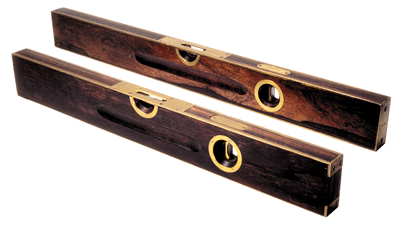American Levels and Their Makers
Stanley Rule & Level Company No. 96
 The
Stanley Rule & Level Company (Stanley) was the most prolific developer and producer
of levels that this country ever saw. Their premier, full size level was the
No. 96 - a brass bound rosewood level with a laminated structure to give it
better stability. In 1898, this level cost $80 per dozen while two unbound Stanley
rosewood of earlier design (Nos. 011 and 11) levels cost slightly more. Four
years later this level still cost $80 per dozen but the cost of all other Stanley
rosewood levels had fallen to nearly half of that price.
The
Stanley Rule & Level Company (Stanley) was the most prolific developer and producer
of levels that this country ever saw. Their premier, full size level was the
No. 96 - a brass bound rosewood level with a laminated structure to give it
better stability. In 1898, this level cost $80 per dozen while two unbound Stanley
rosewood of earlier design (Nos. 011 and 11) levels cost slightly more. Four
years later this level still cost $80 per dozen but the cost of all other Stanley
rosewood levels had fallen to nearly half of that price.
The level incorporated ground glass vials and various new patented features
developed by Justus Traut, Stanley's virtuoso tool maker. The level in the foreground
is an early version. As contrasted to the later version behind it, the early
level has brass tips on the end instead of a brass plate; a nailed-on brass
strip along the top edge instead of the brass corner bindings that were dovetailed
into the wood of the later model; and, the edge binding of the early model stopped
at the end brass instead of locking into it as the later version did. The change
was made possible when the patents of their competitor, Stratton Bros., expired
and Stanley was able to utilize the Stratton technique for the bindings.
Rosewood was used by all level-makers to make their premier models. It was
a stable wood that was readily available and its weight gave the impression
of extra quality. The beauty of rosewood was certainly a factor also, because
not only could one find wonderful grain patterns as in the pictured levels,
but occasional pieces would incorporate bits of light colored sapwood and the
contrast of the two types of wood and their respective grain patterns could
be spectacular.


Copyright 1999 01 Inc., NYC
 The
Stanley Rule & Level Company (Stanley) was the most prolific developer and producer
of levels that this country ever saw. Their premier, full size level was the
No. 96 - a brass bound rosewood level with a laminated structure to give it
better stability. In 1898, this level cost $80 per dozen while two unbound Stanley
rosewood of earlier design (Nos. 011 and 11) levels cost slightly more. Four
years later this level still cost $80 per dozen but the cost of all other Stanley
rosewood levels had fallen to nearly half of that price.
The
Stanley Rule & Level Company (Stanley) was the most prolific developer and producer
of levels that this country ever saw. Their premier, full size level was the
No. 96 - a brass bound rosewood level with a laminated structure to give it
better stability. In 1898, this level cost $80 per dozen while two unbound Stanley
rosewood of earlier design (Nos. 011 and 11) levels cost slightly more. Four
years later this level still cost $80 per dozen but the cost of all other Stanley
rosewood levels had fallen to nearly half of that price.